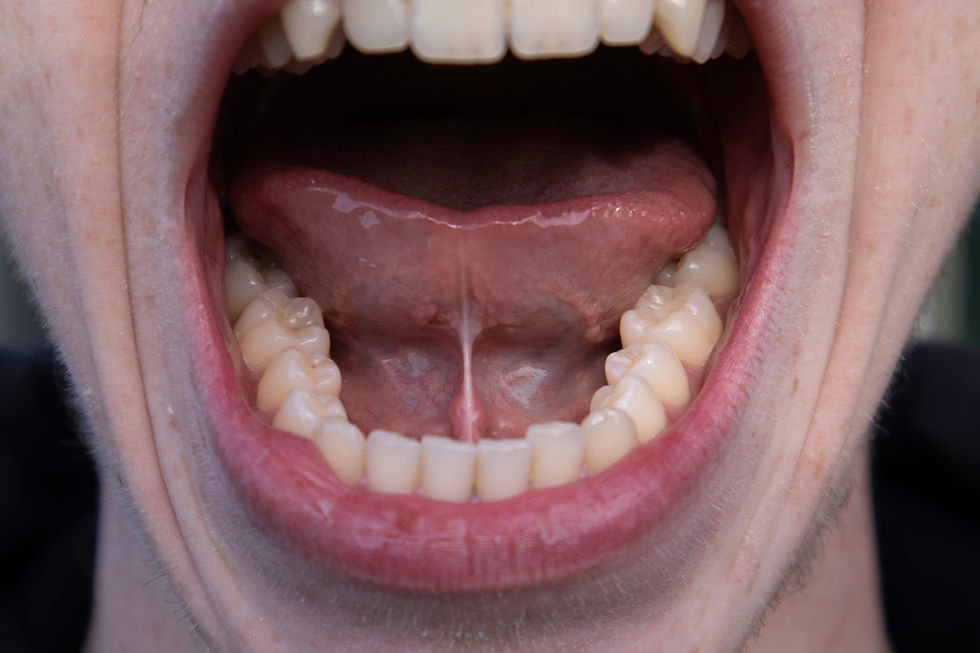What Is Myofunctional Therapy? Could It Help You?
- Melinda Rogers

- May 19
- 6 min read

What Is Myofunctional Therapy?
Myofunctional therapy is a neuromuscular retraining program that focuses on how the muscles of the mouth, face, and throat work at rest and during actions like breathing, swallowing, and speaking.
When these muscles aren’t functioning optimally, it can lead to compensations and dysfunctions that affect everything from your sleep quality to your facial development and speech clarity. Myofunctional therapy helps restore proper oral rest posture, nasal breathing, and functional swallow patterns.
How Is Myofunctional Therapy Different from Traditional Speech Therapy?
While speech therapy and myofunctional therapy are closely related, they are not the same. Understanding the difference can be key to getting the right kind of help.
As a certified speech-language pathologist (SLP), I was trained in communication disorders, including speech sound production, language development, cognition, and voice. However, most SLPs do not receive formal training in orofacial myofunctional therapy (OMT) unless they seek it out as additional, specialized education. Myo is not typically covered in graduate coursework or required for licensure.
Speech Therapy (SLP) | Myofunctional Therapy (OMT) |
Focuses on speech sound production (e.g., R, S) | Focuses on oral function at rest and during movement |
Treats articulation, language, voice, fluency | Addresses breathing, swallowing, and oral rest posture |
Often school-based or medically-based | Often private-pay or airway/wellness-focused |
Trained to assess communication and swallowing | Requires additional training beyond SLP certification |
Treats the symptoms of speech errors | Identifies and addresses underlying causes |
Works on speech clarity and communication goals | Works on tongue mobility, strength, and breathing habits |
Limited focus on airway or oral structure | Screens for tethered oral tissues and oral compensations |
Focuses on what you say and how you say it | Focuses on how your mouth and airway function every day |
Why Combine Both?
When I began integrating myofunctional therapy into my work, I started to view speech and oral function through a much broader lens. I began to ask deeper questions:
Why is this sound still distorted after years of therapy?
Is the tongue able to move freely enough to produce that sound correctly?
Is mouth breathing contributing to open-mouth posture and muscle weakness?
Are tethered oral tissues or airway issues preventing full resolution?
Adding myofunctional therapy to my practice allowed me to better identify the root causes of persistent speech issues and address the underlying muscle and breathing patterns that were holding my clients back.

A More Complete Approach
When we look at speech clarity without addressing oral structure, breathing, and function, we risk treating symptoms instead of causes. By combining traditional speech therapy with a myofunctional approach, I’m able to:
Accelerate progress
Prevent relapse
Improve sleep and breathing
Support overall wellness
This integrated model doesn’t replace speech therapy—it enhances it. And it’s a powerful tool, especially for clients with residual articulation errors, orthodontic concerns, tethered oral tissues, or sleep-related symptoms.
Do I Have a Myofunctional Disorder?
You might not recognize it by name, but an orofacial myofunctional disorder (OMD) could be affecting your daily life more than you realize. These disorders involve improper function of the muscles of the mouth, face, tongue, and airway, especially during rest, breathing, swallowing, and speech.
Many people go years—sometimes decades—without realizing their symptoms point to a functional issue. Below are common signs, what they mean, and why they matter for your health and quality of life.
👄 Mouth Breathing
If you breathe through your mouth more often than your nose—especially at night—it’s a sign that your body is compensating for a dysfunctional airway or poor oral posture.
Why it matters: Mouth breathing dries out the oral tissues, disrupts sleep quality, affects facial development (especially in children), and contributes to fatigue, irritability, and reduced immune function. Long-term mouth breathing can also lead to dental and orthodontic problems.
👅 Low or Forward Tongue Posture
Your tongue should rest gently against the roof of your mouth when you’re not eating or speaking. If your tongue rests low, pushes forward against your teeth, or lies flat on the bottom of your mouth, that’s a red flag.
Why it matters: Improper tongue posture can lead to orthodontic relapse, speech distortions, open bites, TMJ dysfunction, and even restricted nasal breathing. It also impacts the natural growth and shape of the jaw and palate.
🔗 TOTS: The Hidden Restriction

TOTS stands for Tethered Oral Tissues, a term used to describe tongue ties, lip ties, and buccal (cheek) ties. These are soft tissue restrictions that limit the normal range of motion of the tongue, lips, or cheeks. They’re often present from birth but can go unnoticed well into childhood or even adulthood.
What makes TOTS so tricky is that they often hide in plain sight, showing up as subtle but chronic issues across many areas of life.
Why it matters: What makes TOTS so impactful is how subtly they influence daily function. A tongue that can’t lift or move freely may not rest properly on the palate, which disrupts nasal breathing and can contribute to snoring, restless sleep, and even mild sleep apnea. In growing children, this can affect facial development, dental alignment, and airway space.
Adults often experience the effects as jaw tension, neck strain, or a habitual forward head posture, all compensations to help maintain an open airway. And for both kids and adults, restricted mobility can interfere with speech clarity, swallowing efficiency, and even orthodontic success. When left unaddressed, TOTS can lead to a cycle of compensations that affect sleep, focus, energy, and function.

💤 Snoring, Restless Sleep, or Waking Tired
If you snore, grind your teeth, wake frequently, or toss and turn all night, your body may be fighting to maintain an open airway while you sleep.
Why it matters:These are often signs of sleep-disordered breathing, including obstructive sleep apnea (OSA) or upper airway resistance syndrome (UARS). Poor sleep doesn't just make you tired—it affects memory, mood regulation, hormone balance, and cardiovascular health. Myofunctional therapy supports airway function and can reduce these symptoms.
🗣️ Speech Sound Distortions That Persist
If you or your child have struggled with certain sounds—like S, SH, L, or R—despite years of speech therapy, there may be an underlying myofunctional issue like tongue thrust, poor oral tone, or restricted mobility.
Why it matters:When oral structures aren’t supporting precise movement, sound clarity can’t fully resolve. Myofunctional therapy targets the root, not just the symptom.
🦷 Orthodontic Relapse or Bite Issues
Have you (or your child) had braces, only to see the teeth shift again? Is there an open bite or spacing that doesn’t improve?
Why it matters: Orthodontics can move teeth, but they don’t retrain the tongue or lips. If the original muscle patterns aren't corrected, the teeth often shift back. Myofunctional therapy supports long-term orthodontic success.
👅 Tongue Thrusting (Reverse Swallow Pattern)
Tongue thrusting occurs when the tongue pushes forward or sideways against or between the teeth during swallowing, speech, or even at rest. It’s often noticeable during eating or when producing sounds like S, Z, SH, or CH and many people don’t realize they’re doing it.
Why it matters:Tongue thrusting is more than a habit. It’s a dysfunctional muscle pattern that can disrupt proper bite alignment, cause orthodontic relapse, contribute to persistent speech distortions, and lead to inefficient swallowing. Over time, this constant pressure can move teeth out of alignment and create an open bite or spacing, even after braces.
Tongue thrust is frequently linked to:
Low tongue posture
Mouth breathing
Tethered oral tissues (like a tongue-tie)
Enlarged tonsils or chronic congestion
Poor oral muscle tone or coordination
💢 Clenching, Jaw Tension, or TMJ Issues

Frequent jaw clenching, headaches, or clicking/popping in the TMJ area may be a result of poor tongue posture, chronic mouth breathing, or compensatory muscle use.
Why it matters:These habits contribute to chronic pain, fatigue, and even changes in facial appearance. Myofunctional therapy can help restore balance and reduce overuse of the wrong muscles.
🍽️ Difficulty Chewing or Swallowing (or Messy Eating)
Does food fall out of the mouth while chewing? Is swallowing loud, effortful, or accompanied by head or facial movement?
Why it matters:An inefficient or immature swallow can affect digestion, nutrition, speech, and airway health. Myofunctional therapy retrains proper swallow mechanics for safety and efficiency.
🚩 When Should You Seek Help?
If two or more of these signs feel familiar, especially if you’ve noticed them in yourself, your child, or your teen, it’s time to look deeper. These symptoms are often brushed off as minor or cosmetic, but they reflect underlying patterns that impact how you breathe, sleep, speak, and function day to day.
Myofunctional disorders don’t usually resolve on their own and they often worsen over time.
🌟 The Good News?
You don’t have to wait until things get worse. Myofunctional therapy helps retrain your muscles and breathing patterns so your body can function as it was meant to with less effort, better results, and more energy.
As someone who’s walked this path personally and professionally, I’ll meet you where you are and help you move forward with clarity and support.



Comments